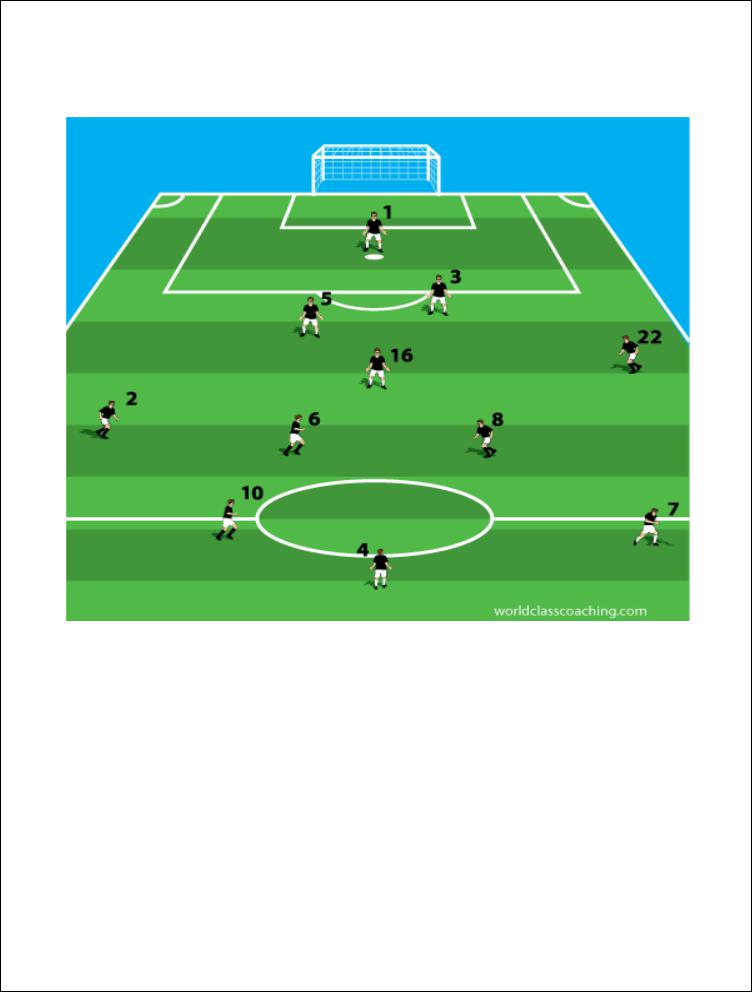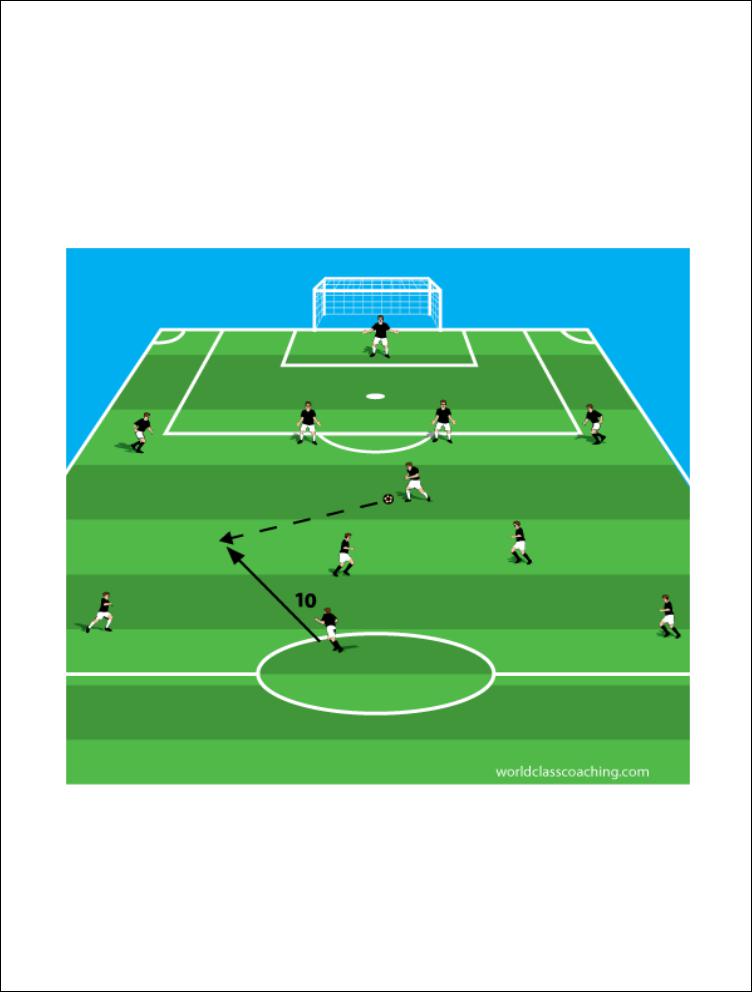
FCBarcelona
.pdf
•Team with most Spanish Cups: 25.
•Longest winning period in La Liga: 16 games from game 7 to 22 in La Liga 2010/11. Team with most points and goals after the first half of La Liga: 52 points and 61 goals (17 wins, one draw and one defeat) by game 19 of La Liga 2010-11.
•Team with most away points in a Liga season: 46 points (14 wins, 4 draws and one defeat in la Liga 2010/11).
•Team with most goals scored in official competitions in a season: 2008/09, with 158 goals in 62 games.
•Most wins in a Liga season: 31 wins in la Liga 2009/10, along with Real Madrid in the same season.
©WORLD CLASS COACHING |
Page | 10 |
FC Barcelona – Style and Domination |

Leadership: A Profile of FC Barcelona Manager Josep ‘Pep’ Guardiola
FC Barcelona manager Josep ‘Pep’ Guardiola starred at the club as a player and has continued his winning ways as a coach. Born on 18 January, 1971 in Santpedor, Guardiola arrived at La Masia, Barcelona’s famous school and dormitory at age 13. A standout both in the classroom (where his affinity for Catalan poetry became apparent) and on the field, Pep earned promotion to the ‘B’ team by 1987. Legend has it that first team coach Johan Cruyff observed Guardiola playing with the second squad and, at half time, directed the team’s coach to move the lanky midfielder to the central midfield to act as the ‘pivot’ or ‘fulcrum’. Guardiola promptly took control of the game and played in the center from that day forward.
Guardiola debuted for FC Barcelona in 1990 vs. Cadiz. A highly talented holding midfielder, Guardiola became one of the key players in Barca’s ‘Dream Team’, winning numerous titles over the ensuing decade. Guardiola also had the opportunity to learn the game from playing and coaching legends Johan Cruyff, Sir Bobby Robson and Louis van Gaal. All told, Guardiola played nearly 500 games for FC Barcelona, winning sixteen trophies while wearing the captain’s band for much of his career with the first team. Guardiola was regarded as a talented, if not overwhelming, athlete and an extremely steady, intelligent organizer of his team on both sides of the ball. Pep left Barcelona as the club settled into mediocrity at the turn of the century, gaining valuable experience in both the Mexican and Italian leagues before his retirement in 2006.
In 2007, Guardiola returned home to Barcelona to coach the ‘B’ team, which subsequently earned promotion in his first season. It was widely thought that Jose Mourinho would be the next coach at Barcelona when Frank Rijkaard was let go later that year (in fact, Mourinho recently said he would have hired Guardiola as an assistant…), but to the surprise of most outsiders, Guardiola was put in charge of the first team.
It was clear that the FC Barcelona leadership wanted to send a message in their hiring of Guardiola. Rijkaard, his predecessor, was a tremendous player but has been, over the course of his coaching career, a moody, improvisational leader. In hiring Guardiola, the FC Barcelona leadership, and president Joan LaPorta in particular, were turning inward, away from big-name international coaches (i.e. Mourinho) and toward a home-grown, stable and visionary coach who would understand the culture of the club.
Guardiola’s impact, both on the field and off, was immediate and indicative of his quality. First, the new coach distributed a three-page ‘Code of Good Conduct’ to the players. Barcelona players had been labeled ‘hedonistic’ and ‘selfish’ in recent years, and Pep’s immediate and enduring message was that the team would be the focus and that to return to national and international domination each team member would need to maximize their focus and contributions. To emphatically illustrate his commitment to finding players focused on the team concept, productive but headstrong players including Samuel Eto’o were shipped off. The result has been a clear understanding that Guardiola has the support of the management and can enforce the mandate that team members behave and conform. Barcelona’s roster is remarkably stable and the players appear to not only respect, but even embrace the message of their coach. Even Lionel Messi, who as a relative newcomer to the first team apparently flirted with the
©WORLD CLASS COACHING |
Page | 11 |
FC Barcelona – Style and Domination |

temptations of stardom, responded immediately to Guardiola’s urging that he focus on the team and his game.
On the field, Guardiola took the framework laid by Johan Cruyff during Guardiola’s playing days and enhanced it. Barcelona plays a fluid, suffocating possession game that Italian coaching legend Arrigo Sacchi has called, ‘The most beautiful soccer cause of recent years.’ The tactical simplicity of the Barcelona game centers around cycling the ball up and down and back and forth across the pitch, wearing down an opponent and creating horizontal and vertical seams that are then exploited to create scoring opportunities. Interestingly, Guardiola deploys midfielders all over the field, a reflection of his belief that these players are the most complete players and those that can play the game at the pace and with the understanding and emphasis on possession necessary to Barca’s style.
The results for Guardiola’s Barcelona have been impressive. In his first year at the helm, the Blaugrana won La Liga (and have won three consecutive years running), the Copa del Rey and the UEFA Champions League. The honors continue to pile up, and despite a flurry of injuries in the 2011-2012 season, Pep has his team in position to compete for the Spanish and European titles (having already earned their second FIFA Club World Cup). The FC Barcelona coach has fashioned a Spanish and European dynasty, and his leadership and tactical vision are critical to the team’s identity and success.
©WORLD CLASS COACHING |
Page | 12 |
FC Barcelona – Style and Domination |

Barcelona 2011-2012: The First Team.
Jersey |
Player |
1 |
Victor Valdes |
2 |
Daniel Alves da Silva |
3 |
Gerard Pique |
4 |
Cesc Fabregas |
5 |
Carles Puyol |
6 |
Xavi Hernandez |
7 |
David Villa |
8 |
Andres Iniesta |
9 |
Alexis Sanchez |
10Lionel Messi
11Thiago Alcantara
13Jose Pinto
14Javier Mascherano
15SeydouKeita
16Sergio Busquets
17Pedro Rodriquez
19Maxwell Scherrer
20Ibrahim Afellay
21Adriano Correia
22Eric Abidal
24 |
Andreu Fontas |
Head Coach: Josep Guardiola
©WORLD CLASS COACHING |
Page | 13 |
FC Barcelona – Style and Domination |

The Barcelona 4-3-3: Creative, Suffocating Attack and Desperate Defense.
Rarely seen in 2011-2012: A common look for the Barcelona 4-3-3 in 2011-2012, though a series of injuries meant that this particular group was rarely on the field together.
Overview:
The Barcelona 4-3-3 features a goalkeeper who is very good at controlling the space behind the defense and also at distributing with his feet; two stay-at-home center backs and two flank defenders who frequently venture forward into vacant flank space. The midfield is best described as an upside-down triangle with a single holding midfielder (pivot or fulcrum) and two very creative attacking midfielders who push hard to get into the attack. The flank strikers typically sit high and wide and try to get isolated and penetrate. The right side striker often tucks in, allowing space for the right back to overlap and serve. This happens less frequently on the left. Finally, the center striker is very non-traditional for a 4-3-3 in that for Barcelona, this player typically is not a big, hammering player, but rather a finesse-oriented player who likes to check back into the midfield.
©WORLD CLASS COACHING |
Page | 14 |
FC Barcelona – Style and Domination |

Style of Play
Barcelona, by their own admission, are obsessed with possessing the ball. Both in La Liga and in the Champions’ League, it’s typical for Barcelona to carry 80% of the possession in a game. When coach Pep Guardiola is asked about his and his team’s tactical flexibility, he is adamant that, “This is what we do (knock the ball around).” The answer is both prideful and a bit defensive in nature, as for Guardiola and Barcelona the quality of their play is nearly as important as the result, and both the staff and team believe that their relentless possession will lead to wins, and their results over the past several years support this assertion. The nature of the possession is sometimes a bit dull, as two or three players will knock the ball back and forth in a small space, compelling their opponents to chase, and then suddenly brilliant as a third man running blazes into space and is found with a timely pass. Of course the knocking of the ball in small space creates the space and time for the dangerous run, but one gets the feeling that Barcelona simply revel in the small area passing anyway. One commentator observed this season that for many watching Barcelona, it’s the science of their game that we try to dissect, whereas for the team and coaching staff, the art of the game is their focus.
Speed of Play
The style of play is admirably and stubbornly focused on possession and the speed of play within that framework is a critical component to the success of the Barcelona style. The team are very conscious of the speed at which they play and they occasionally slow play, but generally speaking they seem to revel in a speed of play that is right at the edge of their collective ability to hang onto the ball and Guardiola understands that this is critical to the team’s ability to wear down and stretch opponents. Often it appears that their possession will be broken because they are willing to play in such tight space and their opponents squeeze them into confined space, but the general rule is that the Barca players respond with more quick passing to wear down defenders and break pressure. The vision is clearly that the game is a series of small-sided (i.e. 2 vs. 2 or 3 vs. 3) encounters and that superior technical speed, tactical speed, superior physical speed and early running off of the ball will allow the team to dictate play.
Central Possession, Attack Exposed Flanks
The engine, so to speak, of a 4-3-3, is the midfield triangle and the Barcelona trio of Busquets, Xavi and Iniesta. Busquets is an intelligent, mobile and tough player who acts as the pivot at the base of the triangle. He does a nice job of sitting underneath the other players to relieve pressure and/or change fields. Iniesta and Xavi are energetic, sharp, creative and intelligent players who seem to live to pass and receive the ball. They confound marking with their ability to dart in and out of space and they are able to find one-another seemingly without looking. Add to this dynamic mix the fact that Messi often ghosts back into the area to help organize and run the opposing midfielders (and the Barcelona outside backs sometimes join in as well), and it’s easier to understand how Barcelona dominate the center of the field.
Often, teams thrust a center back into the midfield space (usually in pursuit of a checking forward) or condense centrally their four-man midfield to try to disrupt Barcelona’s possession.
©WORLD CLASS COACHING |
Page | 15 |
FC Barcelona – Style and Domination |

The result is that the wing forwards (Villa, Pedro, etc.), can become isolated against a single defender and the midfield group for Barcelona are very adept at playing these players into dangerous space. Barcelona also like to pull a wing forward inside and/or into midfield space to join the possession game and then overlap the outside back (Alves or Abidal) into this same space. Alves often looks more like an outside midfielder or wing forward than he does an outside back. If teams are able to maintain enough defensive support on the flank to avoid these dangers, then the central group typically finds interior seams in which to penetrate the defense.
A Team of Midfielders
Interestingly, Guardiola has filled his roster with players who are midfielders or who possess many of the qualities of midfielders. Xavi Hernandez (6), Andres Iniesta (8), Cesc Fabregas (4), and Sergio Busquets (16), all mainstays in the midfield triangle, crave possession of the ball and, like Guardiola in his playing days, can act as quarterbacks, organizing the team to dominate the pitch. Many of the other regulars who play on the front and back line in Barca’s lineup are extraordinarily comfortable on the ball and often cyle through the midfield while the team is in possession. Lionel Messi (10) confounds opponents by ghosting back into the midfield, creating an overload in that area and also freeing flank space for Danny Alves (2) to fly up the flank. Alves and Abidal (22) frequently look like outside midfielders when the team is in possession, pushed up high and sometimes even central in the midfield as the team swarm around, paralyzing teams’ efforts to press the ball. Both are very comfortable on the ball and see the field very well. Even Victor Valdes in goal seems bent on building possession through short passes in front of his goal. Such stubbornness led to Valdes conceding an early goal against Real Madrid in the first edition of the Classico in 2011-2012, but Valdes went right back to playing short out of his area under pressure and contributed to wearing down Real Madrid to the point that the game seemed well out of hand (3-1) with nearly twenty minutes remaining. Thus, Barcelona’s 4-3-3 is a midfield possession dominated system made great by a group of players (at every position) who think and play the game like midfielders.
Depth
Another remarkable characteristic of Guardiola’s Barcelona is the depth that the team exhibits. This is a compliment both to the management and also to the coach, who clearly understand the need to be able to rest and replace players in the lineup and maintain the rhythm and performance of the team. Barcelona plays an extremely ambitious club schedule, ranging from La Liga to the FIFA Club World Cup (requiring travel to Japan in the midst of the league schedule), and this year’s squad has endured lengthy absences to injury and illness, particularly Pique and Villa, but also Pedro, Abidal, Busquets and others. To the immense credit of both the players and management, players like Alves, Mascherano, and Thiago have filled in admirably, often while playing out of position, and the team plays and performs at the same level. This is particularly noteworthy and important given the rhythmic passing style and high-pressure defending the team features. Guardiola has also intelligently rested his top players on occasion to help them endure the lengthy season, and the confidence he has shown in his reserves has paid dividends on the field and, surely, helps team morale as well.
©WORLD CLASS COACHING |
Page | 16 |
FC Barcelona – Style and Domination |

Set Up and Find the Third Man
Barcelona is perhaps the best current example of a team that possesses to set up and find the socalled ‘third man’. Tactically speaking, a third man is a player making a run off of the ball. Often this player is the beneficiary of several short passes between other players that condense the defense so that his/her run off of the ball puts the player in space when the ball is played to the third man. What separates Barcelona from other clubs is that the runners and passers seem to have uncanny timing (particularly given the club’s speed of play) and the fact that in such a freeflowing style of play there is still considerable discipline in the sense that runners are finding the critical space and the right moment.
Barcelona’s ‘False 9’ - #10 Lionel Messi
Utilizing the ‘False 9’
Perhaps the compelling tactical variation utilized by Guardiola’s Barcelona is the deployment of a ‘false 9’ at the striker position. In the 2011-2012 season, Lionel Messi (#10, above)played the lion’s share of minutes at the center striker position in the 4-3-3, but Cesc Fabregas also saw time at the point as well. The term ‘false 9’ refers to the use of player at the point who does not fit the
©WORLD CLASS COACHING |
Page | 17 |
FC Barcelona – Style and Domination |

traditional center striker role either in characteristics or particularly in the role the player assumes within the formation. Traditional center strikers, particularly in the 4-3-3, tend to be big, hammering, holding players who can win balls and distribute in transition and then wreak havoc in the opposing box, getting on the end of crosses and muscling defenders to finish rebounds. The USA’s Abby Wambach and Uruguay’s Umberto Suazo are current examples of attackers who fit this description. Messi and Fabregas, on the contrary, are players who would likely be more comfortable attacking in space on a flank and/or receiving facing the goal. They are more midfielder than forward.
For Barcelona, both Messi and Fabregas are text book examples of a ‘false 9’, as Messi in particular frequently drops deep into the midfield before making slicing runs into the opposing backline. This withdrawn, unpredictable positioning offers several advantages to Barcelona’s attacking:
•The center forward is difficult to mark. Does the opposition release a center back to chase the false 9? Do they pull their holding midfielder deeper to screen passes into the false 9? Either way, the collective defending block of the opposing team is altered and weakened.
•As the center forward withdraws, he or she creates an overload in the midfield. Messi’s ability to check sharply back and organize with Busquets, Xavi and Iniesta, often makes it look like they are playing 4 vs. 2 in the middle of the field. Opposing central midfield tandems are run ragged by the speed and rhythm of this possession.
•Often the center forward’s deep check into the midfield facilitates breaking pressure on one side in the midfield through a pass to his feet to change fields. Messi in particular has a very good sense of when his help is needed to defeat opponents’ pressing in the middle third.
•A smaller center forward such as Messi, on withdrawing, can find room in which to turn and face the defense, which is often difficult for smaller forwards to do when receiving in the heart of the defense.
•Relatedly, once faced up in possession, the false 9 has excellent angles for playing in his or her wing forwards. This is particularly true if an opposing center back tracks the false 9 into the midfield but is unable to prevent him or her from turning, as the opposing back line is weakened and seams become more pronounced.
•When Messi checks down into the midfield, one of the attacking midfielders (or a wing forward) often make deep runs in behind the defense in the space he vacated, particularly if his run has pulled apart the defending block.
Barcelona Defending: Mentality
Guardiola is often quoted as saying, “We are a terrible team without the ball. We have to have the ball.” This is quite a statement from the coach of what is arguably the best club team in the world over the past three years. The best way to characterize Barcelona’s team defending is a desperate hunt for the ball. Because the team is so spread out (particularly on the back line) in possession, Barcelona are vulnerable to counterattack and the team look disorganized sometimes without the ball. It is evident that they are aware of and sensitive to the danger, and it is remarkable to watch them swarm the ball in the first few seconds after possession is lost. Word
©WORLD CLASS COACHING |
Page | 18 |
FC Barcelona – Style and Domination |

is that Guardiola uses a stopwatch in training and allows six seconds for the team losing the ball to win it back, and this sense of urgency is very apparent on game day as well. One of the advantages of the 4-3-3 system is that when possession is lost, there is typically a player or several in the area to apply immediate pressure.
©WORLD CLASS COACHING |
Page | 19 |
FC Barcelona – Style and Domination |
